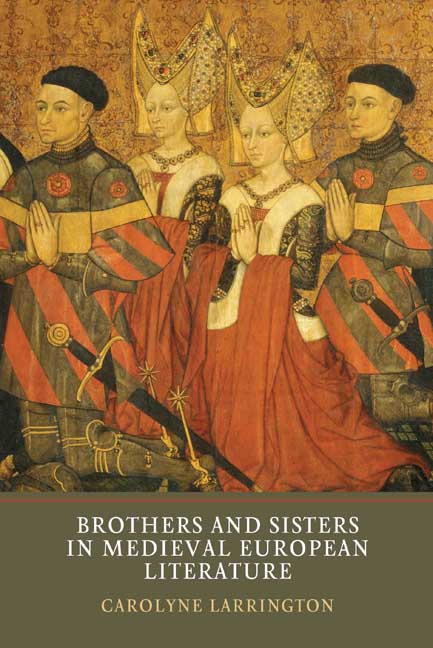Book contents
- Frontmatter
- Dedication
- Contents
- Acknowledgements
- Abbreviations
- Introduction
- 1 The Medieval Sibling in History
- 2 ‘Berr er hverr á bakinu nema sér bróður eigi’: Fraternal Love and Loyalty
- 3 ‘Io v’ho cara quanto sorella si dee avere’: Sisters, and their Brothers
- 4 ‘Næs þæt andæges nið’: Fraternal Hatreds
- 5 ‘Te souviegne de ce que je suis ta seur’: Sisters and Hostility
- 6 ‘The king’s dochter gaes wi child to her brither’: Sibling Incest
- 7 ‘So wil ich dir ce wibe mine swester gebn’: When Siblings Marry
- 8 ‘Trewethes togider that gun plight’: Fictive Siblings
- Conclusion
- Bibliography
- Index
3 - ‘Io v’ho cara quanto sorella si dee avere’: Sisters, and their Brothers
Published online by Cambridge University Press: 08 May 2021
- Frontmatter
- Dedication
- Contents
- Acknowledgements
- Abbreviations
- Introduction
- 1 The Medieval Sibling in History
- 2 ‘Berr er hverr á bakinu nema sér bróður eigi’: Fraternal Love and Loyalty
- 3 ‘Io v’ho cara quanto sorella si dee avere’: Sisters, and their Brothers
- 4 ‘Næs þæt andæges nið’: Fraternal Hatreds
- 5 ‘Te souviegne de ce que je suis ta seur’: Sisters and Hostility
- 6 ‘The king’s dochter gaes wi child to her brither’: Sibling Incest
- 7 ‘So wil ich dir ce wibe mine swester gebn’: When Siblings Marry
- 8 ‘Trewethes togider that gun plight’: Fictive Siblings
- Conclusion
- Bibliography
- Index
Summary
Introduction
The previous chapter showed how brothers are imagined as working to reconcile the drive for differentiation from their male siblings with the strong social norm of kinship solidarity. However, opportunities for sisters to demonstrate love and loyalty are much rarer in medieval narratives. Girls often marry young; if they are of high social status they frequently live far from their natal family in their husband's household. Enduring what Claude Lévi-Strauss calls ‘the hard fate of exiles’, their interactions with their siblings tend to become restricted. Meetings with other sisters who have also married away or who are in the convent are limited; this consideration accounts for the relative paucity of medieval stories about pairs of sisters when one or both are married. In lowerstatus families by contrast the historical sources examined in chapter one show that married sisters very frequently spent time together, helping one another with childbirth and child-raising and socializing in family groups (see p. 34). In fourteenth-century urban literature, such as the Decameron, when a sister marries into another mercantile family she simply moves to another street in the city and her siblings remain closely involved in her life.
For medieval authors, women only become interesting to write about when they become old enough to marry. Although sisters are often imagined to be rivalrous, particularly in matters of love as we shall see in chapter five, a number of medieval stories in different genres show that sisters can also be loyal and self-sacrificing. ‘Intense loyalty and sustained caregiving are not based on simple strategic or temporarily convenient alliances’, note Bank and Kahn: ‘Loyalty involves feeling and identification with the other person; it also requires tangible action.’ This chapter focuses on sisterly loyalty, whether expressed for another sister or for a brother, through the kind of ‘tangible action’ that complicates the plots of medieval narrative as often as it resolves them. The chapter also examines brothers’ positive regard for their sisters and the limits to that regard. Juliet Mitchell argues that unresolved sibling relationship issues can result in social groups who ‘do not relate to each other on the basis of a mutual recognition of the other's consciousness’.
- Type
- Chapter
- Information
- Brothers and Sisters in Medieval European Literature , pp. 76 - 103Publisher: Boydell & BrewerPrint publication year: 2015



